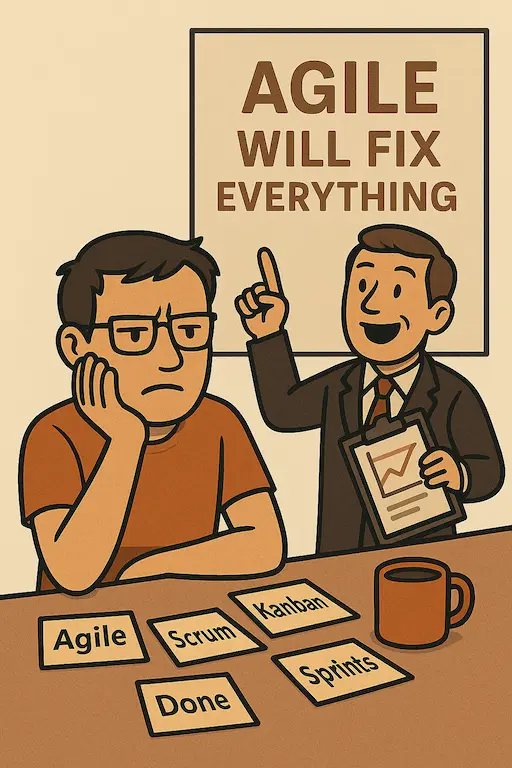
Agile isn’t your problem.
Agile is dead. Long live Agile.
Every few years, someone revives the corpse, dresses it up in a new three-letter acronym, and wheels it around the office like it’s going to save your team. Again.
This time it’s “SAFe.” Last time it was “Spotify Model.” Before that, it was Scrum with capital-S and a two-day certification course. You sit through the same slides. Someone renames standup to “daily sync.” Jira gets a new plugin. Leadership announces this will bring “clarity and velocity.”
And then… nothing changes.
Because Agile was never your problem.
What Agile Actually Is
Strip away the branding and it’s embarrassingly simple. Agile is:
- Just enough structure to let teams deliver good software quickly
- A way to shorten feedback loops so you stop building the wrong thing
- A way to change direction without needing a three-month steering committee
That’s it. Not complicated. Not sacred. Certainly not trademarked.
Agile is lean—not in the Six Sigma sense, but in the “we don’t need all this ceremony” sense. It’s supposed to help us move. But most teams are stuck lugging around a bloated version that can’t.
What It Looks Like When It Works
You want to know what a healthy Agile team looks like? It doesn’t look like your Jira dashboard.
It looks like:
- Developers talking—constantly, and not just during standups
- Pair programming when it helps, not when the process says so
- Teams who own the product, including how it behaves in production
- Enough time to write proper tests and refactor without begging
- Everyone knowing what the goal is and why it matters
- A calm, steady pace—not a death march disguised as a “sprint”
- Monitoring and alerting built into the work, not bolted on later
Also? High-performing teams barely need standups. They talk because they’re solving problems together, not because it’s 9:30.
Where It Goes Wrong (Every Time)
The failure modes are so predictable they might as well be printed on the backs of Gantt charts.
The most common: management still thinks in waterfall, but wraps it in Agile vocabulary. Story points become hours. Roadmaps become commitments. Feedback loops become performance metrics.
Teams are asked to be “self-organising,” but aren’t allowed to say no. Or question the backlog. Or delete a useless meeting. Or deploy something on a Friday.
Meanwhile, every feature request has a due date. Planning becomes forecasting. Velocity becomes KPI. And somewhere along the way, people stop caring.
And Then There’s the Internal Rot
Even if management gets out of the way, Agile can still rot from the inside.
- Teams that don’t feel ownership stop building for the long term. They skip monitoring. They avoid refactoring. It’s not their problem.
- The knowledge hoarder becomes the go-to for every question—because the system is complex, undocumented, and fragile.
- Lone wolves resist pairing. The team avoids hard conversations. Everyone sticks to their lane.
- “Scrum” becomes a checklist, not a conversation. Ceremonies persist, belief does not.
At some point, it’s not even Agile anymore. It’s just a theatre performance, and nobody’s buying tickets.
What Actually Helped
Here’s a story.
On one team, the big breakthrough came when we quietly dropped Scrum. Just stopped pretending. No more pretending we were sprinting. No more pretending pointing stories was helping. No more pretending a weekly retro was going to change anything.
We didn’t replace it with anything fancy. We just built a lightweight process that made sense for us. Something that let us breathe.
And guess what? People got happier. Code got better. Fewer incidents. More laughter. More trust.
Imagine that.
To Be Continued…
You don’t fix these problems with another retrospective. You fix them by starting small, getting real, and stopping the performance.
In Part 2, I’ll talk about what to do when the damage is already done—how to rebuild trust, reclaim ownership, and actually make Agile feel like… well, Agile.
But for now, just know this: if Agile feels exhausting, it’s not Agile. It’s cosplay.
Burn the playbook. Keep the principles.
And whatever you do—don’t go to another SAFe workshop.